Daniel Farke and Norwich City’s return to the Premier League at the first attempt made for impressive viewing. His side played some magnificent football, spearheaded by possibly the greatest individual Championship season of all time produced by now-Aston Villa winger; Emiliano Buendía. They scored the second-highest number of goals in the division (only behind Brentford) on their way to the title.
This side, though, was built upon solid foundations. They only conceded 36 goals in 46 games, again second-best (this time to Watford), thanks to the hard work of Oliver Skipp in midfield, who did a fantastic job as a mobile defensive midfielder who screened the backline superbly. In this scout report, we will detail why Billy Gilmour is the perfect evolution for what this role in the team can provide.
In this tactical analysis, we will look at his limited minutes for Chelsea at senior level, uncover why he is a man of the match machine, and why Farke has picked out him as the ideal midfielder for his system.
Player profile
As a young kid, Billy Gilmour was raised on the west coast of Scotland, in a little town called Ardrossan. A town rife with a drinking culture (as are many across the UK), Gilmour did not follow that tradition and instead spent that time working hard on his craft. Even now, he is a humble young man who enjoys heading back home when he can to keep himself grounded, to keep himself in an environment where he is not surrounded by choirs of praise. It is part of why his rise to the top has been so unwavering.
He always wanted to be a football player ever since he was in his early years, and later on into his teens, he discovered it was going to take sacrifice. At the age of 16, Gilmour moved 433 miles away from his family to Cobham, home to Chelsea’s prestigious training ground and academy. He initially shared a room with then-new signing, Daishawn Redan, (now at Hertha Berlin) in digs near the academy itself. It would not take long for Gilmour to settle himself down and make an immediate impression.
Two seasons in the youth team preceded a pro debut against Liverpool in the EFL Cup during the 2019/20 season, where an 18-year-old Gilmour produced a man of the match display. He would get used to receiving those in the year to come. Ten appearances but well under 500 minutes would follow for the rest of the season, and in the 2020/21 season, he gained marginally more time on the pitch. Arguably less than he deserved based on his performances versus the likes of Mateo Kovačić at the time.
At 5’6” / 170cm, Gilmour is a player who does not let his petite figure adversely affect his performance. In fact, he uses his small frame to his advantage, as he is incredibly difficult to dispossess off the ball, with even players such as Fabinho of Liverpool struggling in this case. He has a footballing brain that enables him to be a step ahead of his opposing man at any time. He actively invites pressure, knowing he will not succumb to it. Once he is past them, his passing range and accuracy are not bad either.
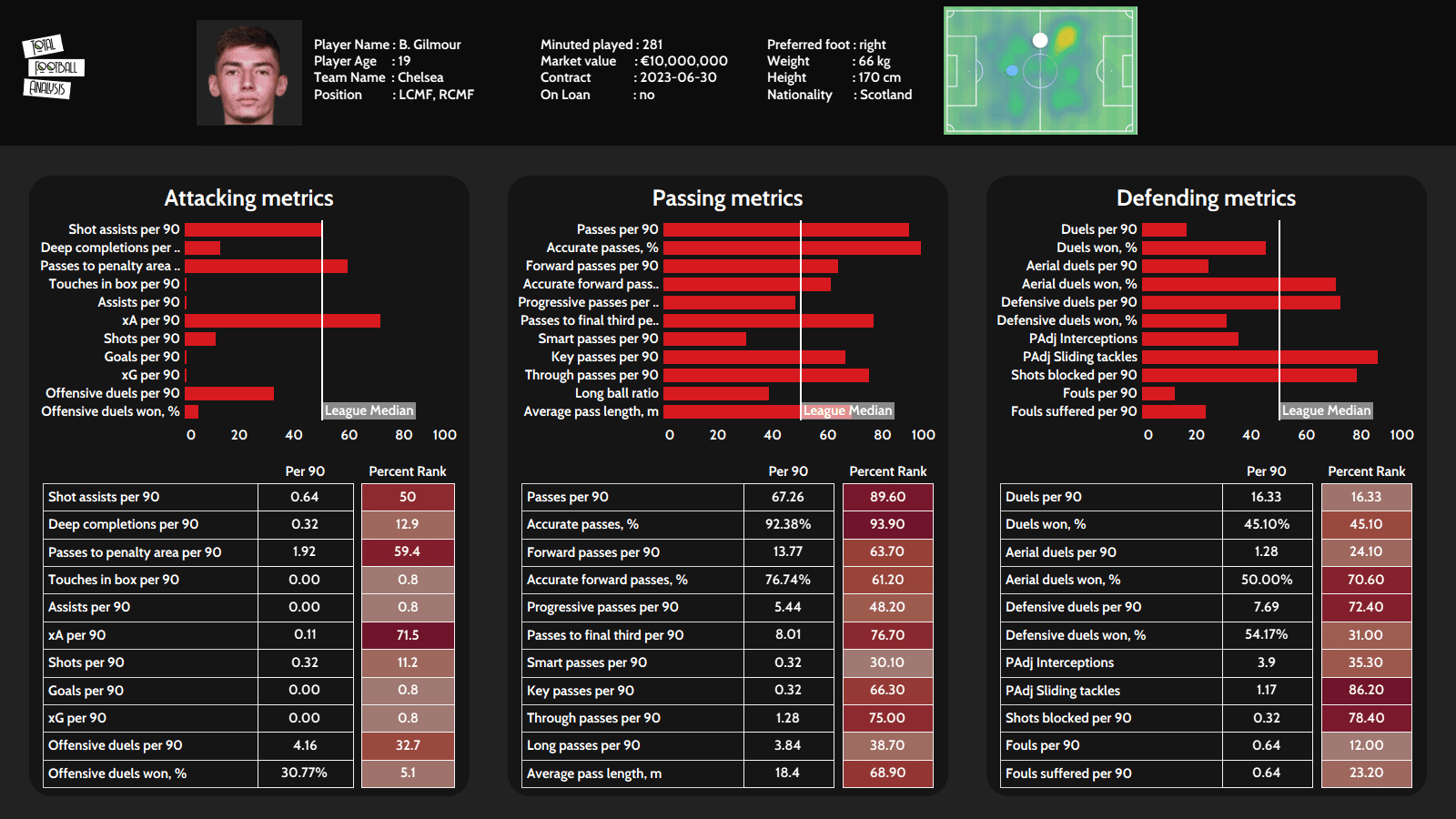
Billy Gilmour’s player profile, created by the wonderful Sathish Prasad, so are the fantastic radars further down the piece. Check out his Twitter @SathishPrasadVT.
World-class ability on the ball
Now, this comment is no hyperbole, it is something that the folks over at Norwich truly believe; Norwich see Gilmour as a world-class talent on the ball. This is a statement that is evidence-based as well, and his most recent man of the match performance, a Euros debut against England, was a testament to what Norwich were saying about him behind the scenes. He’s got flair and tenacity.
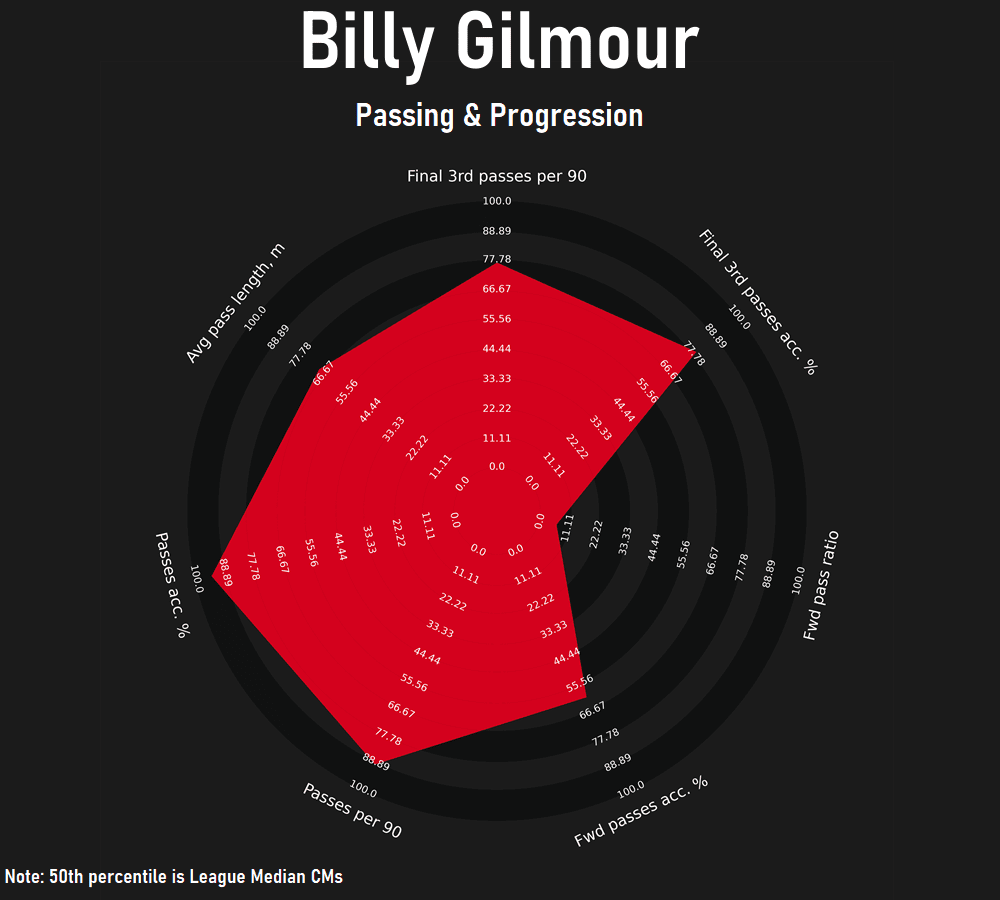
Billy Gilmour’s passing and progression radar from the 2020/21 Premier League season.
Although limited minutes at a senior level leave us unable to say everything with absolute confidence – but the early signs are devastatingly promising. The way he collects the ball draws in his man, and steps into space are effortless and tidy. Through his ball-carrying ability, he creates enough room to have leverage over where he wants the ball to go next.
In deeper phases of play, there is a concerted effort to play the incisive pass forward. When he joined the club, he began to model his game off Cesc Fàbregas, who accompanied N’Golo Kanté in a 3-4-3 at the time. While Kanté was the nimble destroyer, Fàbregas’ role was to first make sure he did not neglect his defensive duties under Antonio Conte, but primarily to progress the play with his passing range. Gilmour has looked to do the same both with a defensive partner and as a lone ‘6’.
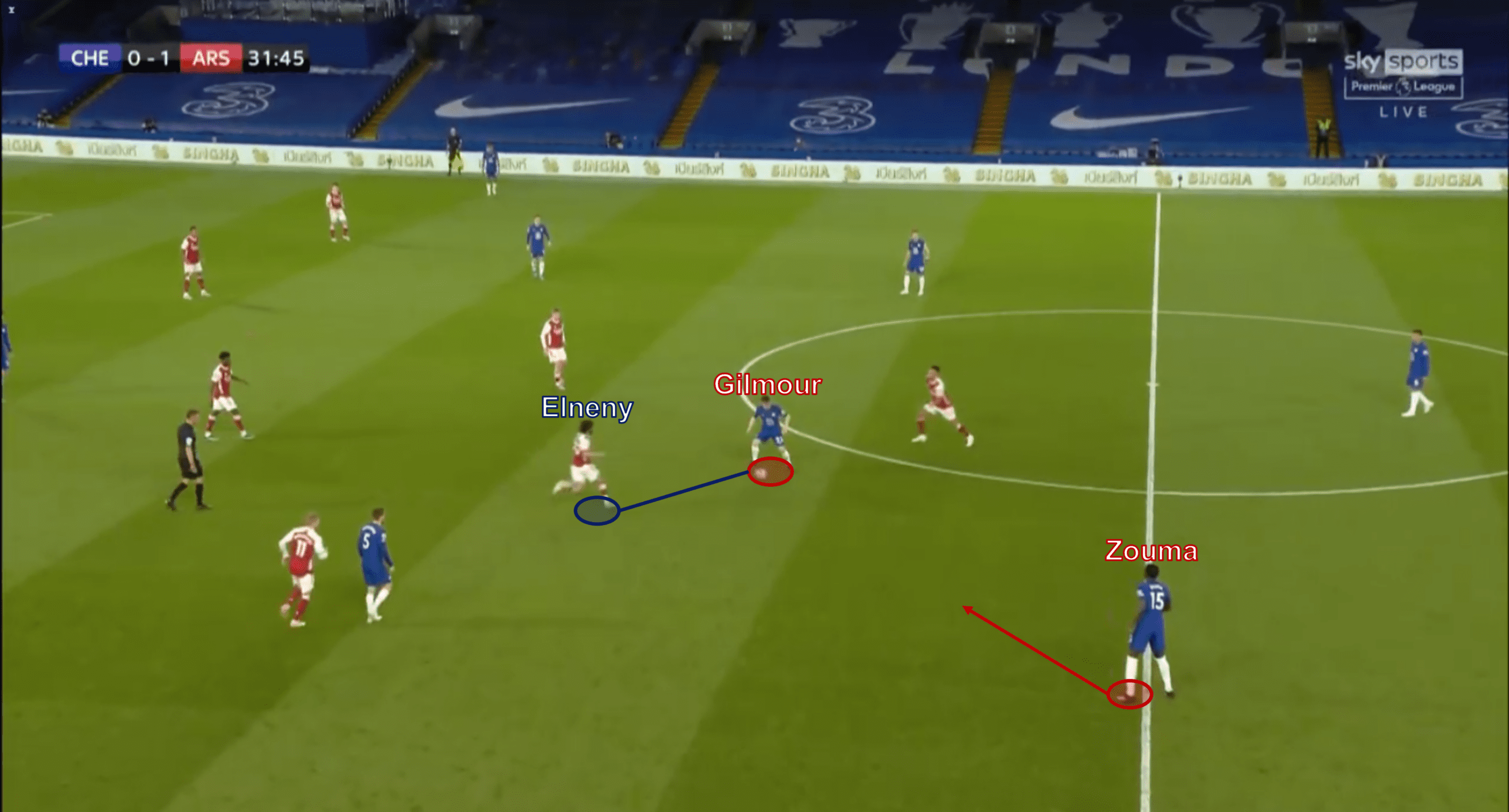
Zouma here lays off the ball to Gilmour in midfield, who has Elneny tracking his location.
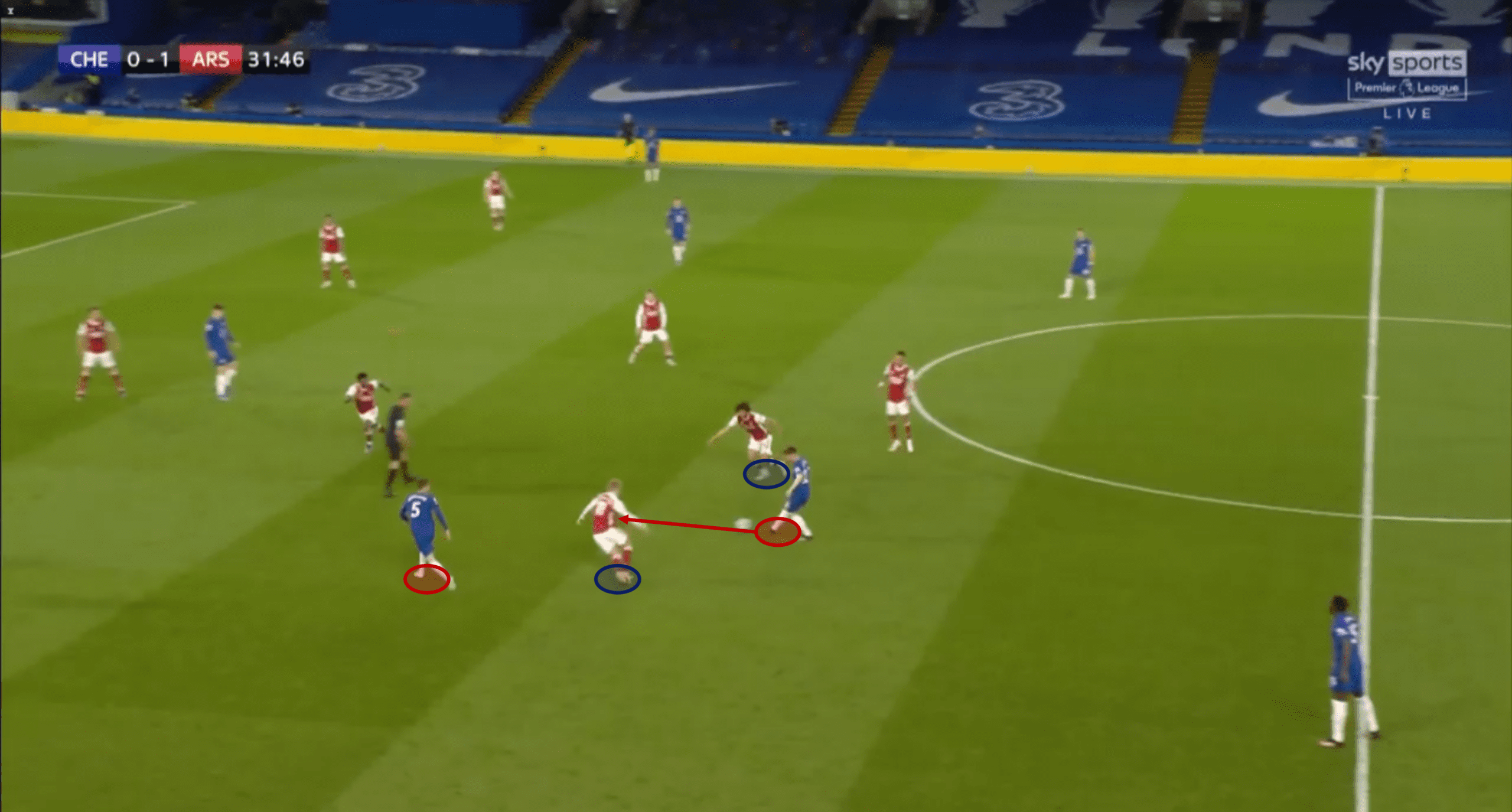
He takes a touch into space and plays a line-breaking pass into Jorginho further up the pitch.
His short-medium passes are typically neat and accurate, and he usually aims for players in enough space to receive the ball, which can sometimes disrupt the tempo that the team is building on one side of the pitch. This is potentially an area for improvement, not that he feels pressured to pass the ball as soon as he collects it – it’s more about his understanding of different game states and match tempo.
What is most distinctive about his game is his dribbling. He carries the ball with such a buoyant aura – there is no fear even when there are multiple players on his location. He uses his opponent’s momentum against them and in favour of him. A quick swivel and drive into another direction to keep possession and quite frequently to break opponent pressure and bypass it.
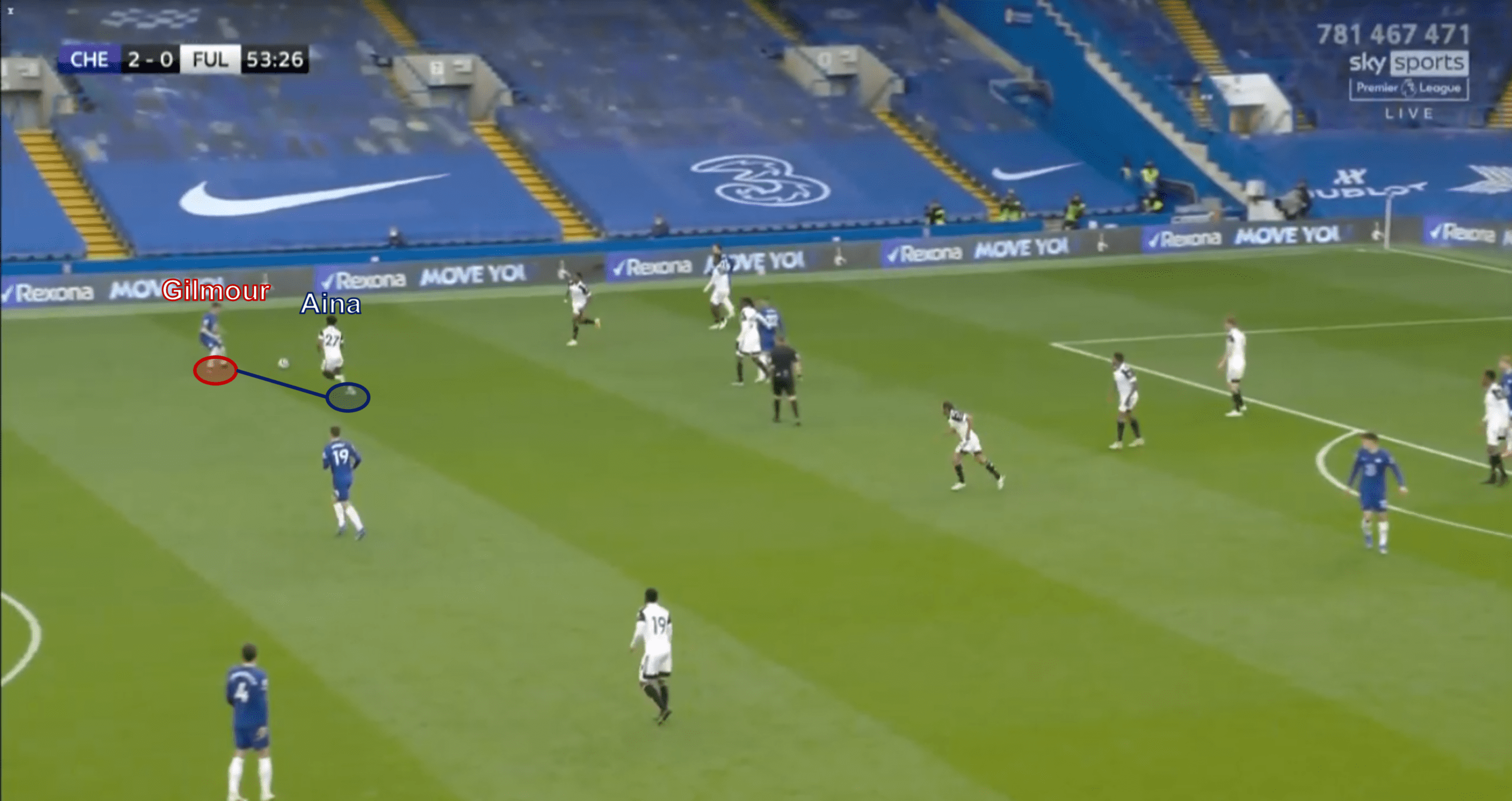
The ball comes to Gilmour’s feet, with Aina tracking the movement of the ball.
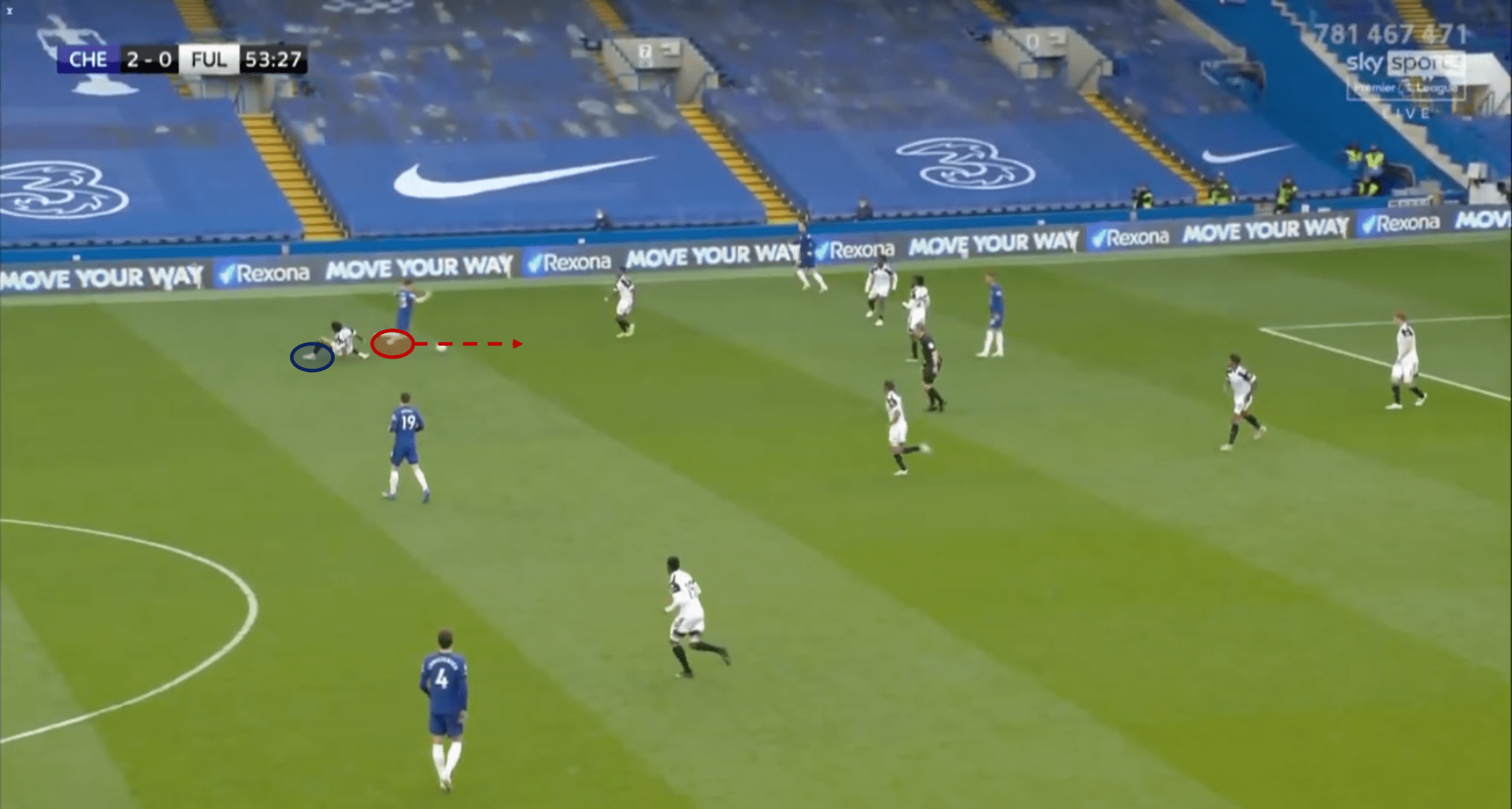
He uses Aina’s momentum against him to glide past the full-back.
Farke’s main objective for Gilmour on the ball is to improve his reading of the game and positioning to enable the 20-year-old to intercept more frequently than he currently does – adding another string to his Scottish bow. Norwich will want to be more compact than when they were last in the Premier League, and Farke will want Gilmour to play a key part in that – but ultimately his greatest asset as a player and the biggest benefit he will bring to this Norwich team is through his progressive line-breaking abilities on the ball, with his work off the ball being serviceable enough to survive in the English top-flight.
Expect him to be partnered by a mobile ‘6’
One area that Gilmour is not expected to excel is in his influence off the ball. He does not possess the requisite speed or power to act as the defensive partner in a midfield pivot, he will need to be accompanied by someone with better athleticism and defensive prowess. Not to say Gilmour is a poor defender, but someone of his height and physical profile can’t be expected to do it all on his own.
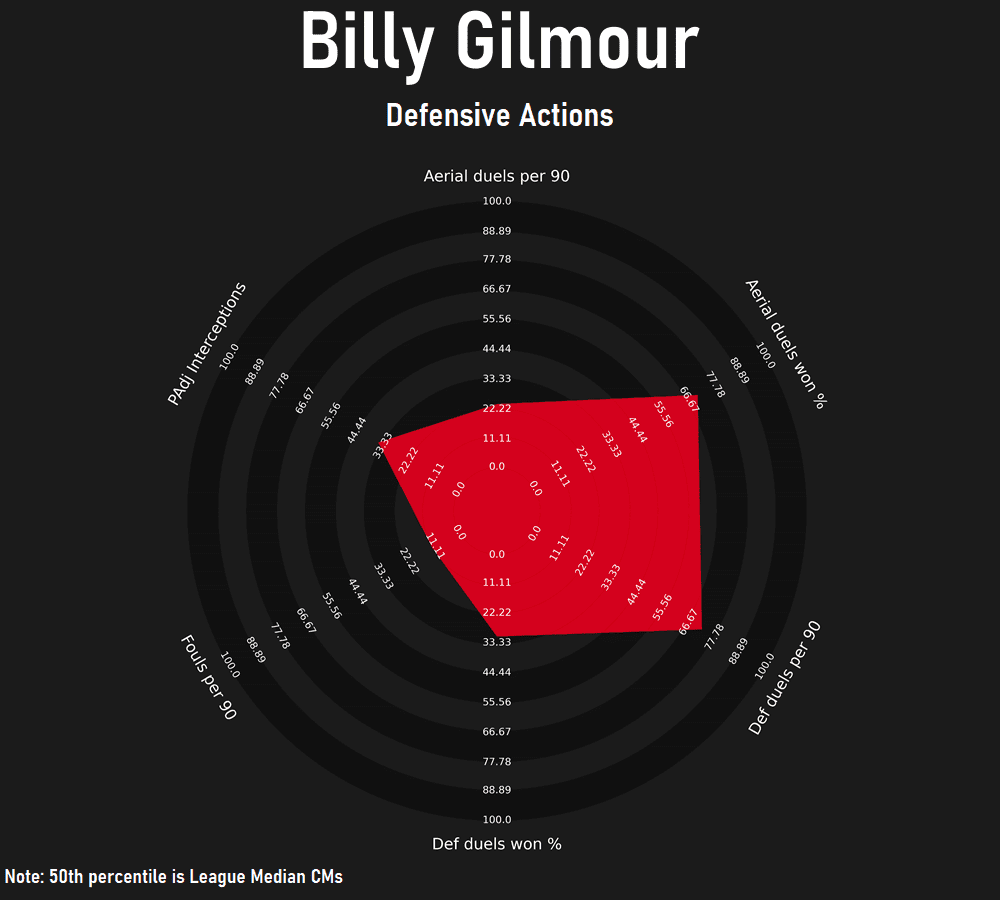
Billy Gilmour’s defensive actions radar from the 2020/21 Premier League season.
Again, these numbers are barely reliable due to his lack of minutes at the senior level, but by taking a look at his footage, we can gain an understanding of where his pitfalls are off the ball, but also where he performs well too. He has demonstrated some solid defensive fundamentals in the base of a 4-3-3 midfield, with good positioning to cover the midfield pivot ahead of him.
This has helped him develop his interception numbers, reaching as high as 1.9 per 90 in the Champions League season gone by. He has the defensive intelligence to defend spaces really well and is generally unbothered when a player makes runs behind him if he has been instructed to maintain a defensive structure. It’s definitely a strength defensively for Gilmour.
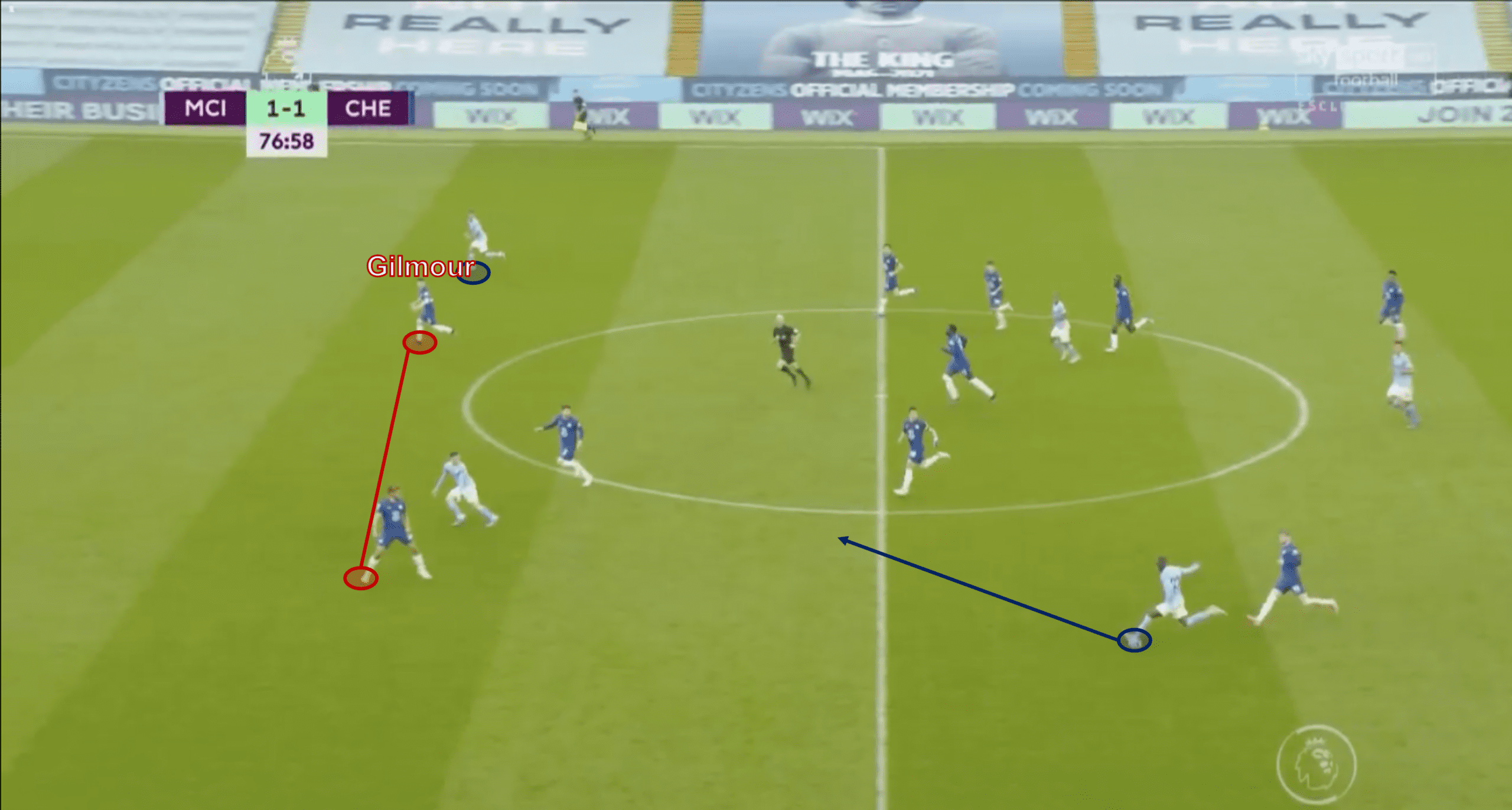
Noticing that the backline is out of shape, Gilmour drops into the nominal centre-back space to plug a gap.
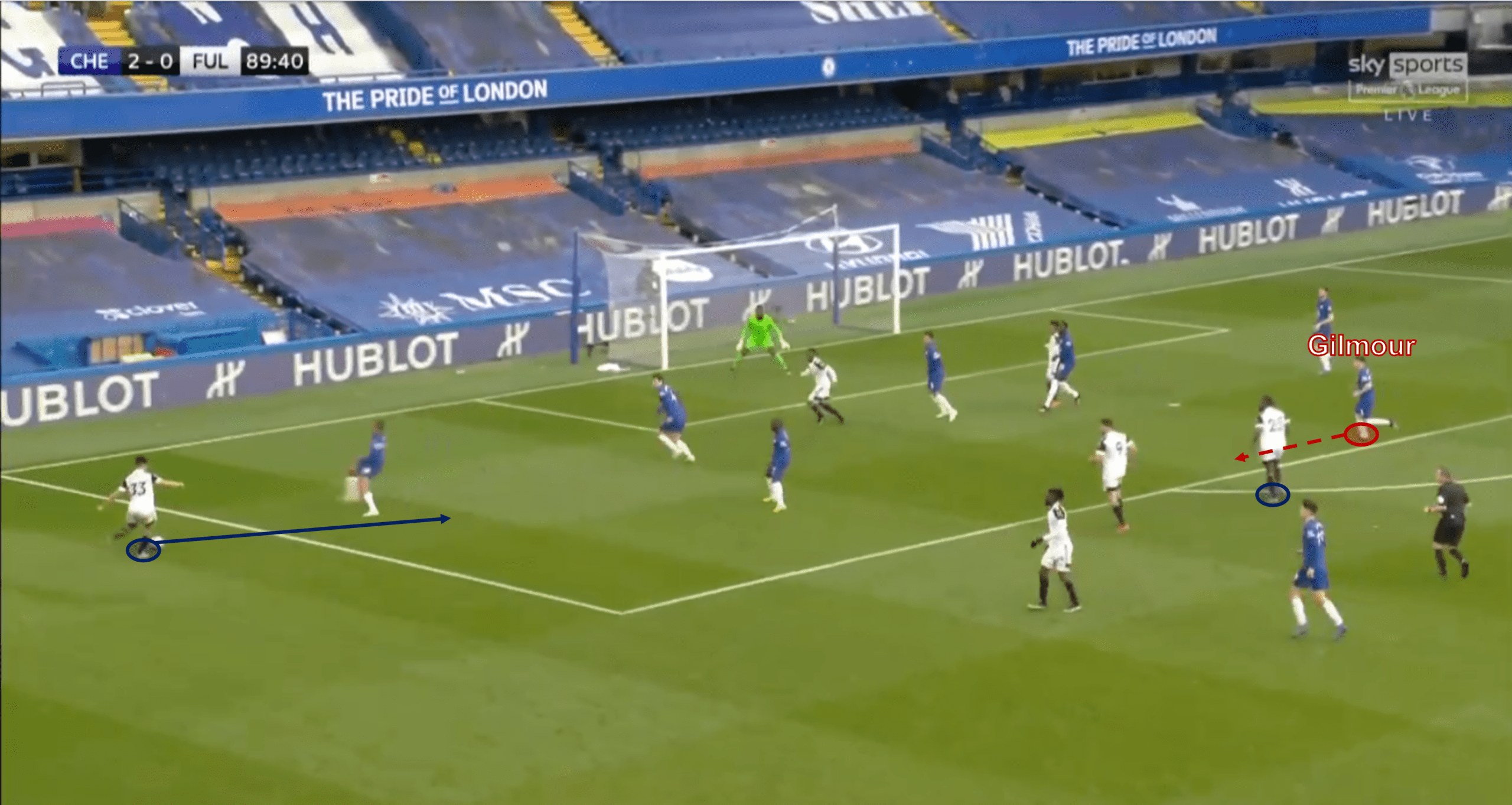
Against a Robinson cross, Gilmour cleverly steps into the space that the ball travels to, intercepting the ball and preventing a potential shot.
Gilmour in defensive duels is all-in. He leaves it all on the table, not a capsule of energy left unspent. According to Gilmour, he gets this from his father, Billy Gilmour Senior, who was a midfielder himself up in Scotland back in the day. His father knew that, for Billy Junior, as a small player, he would need to put double the effort in his defensive duels.
Although not afraid to put a foot in, Gilmour can occasionally lack confidence in his decision-making defensively. He certainly is not one to shy away from a tackle, but his concern to be beaten by his man is shown when there is space between him and his marker. He can be unsure whether to step to his man, try to win the ball back, or keep his distance and wait for the pass that could come, to intercept.
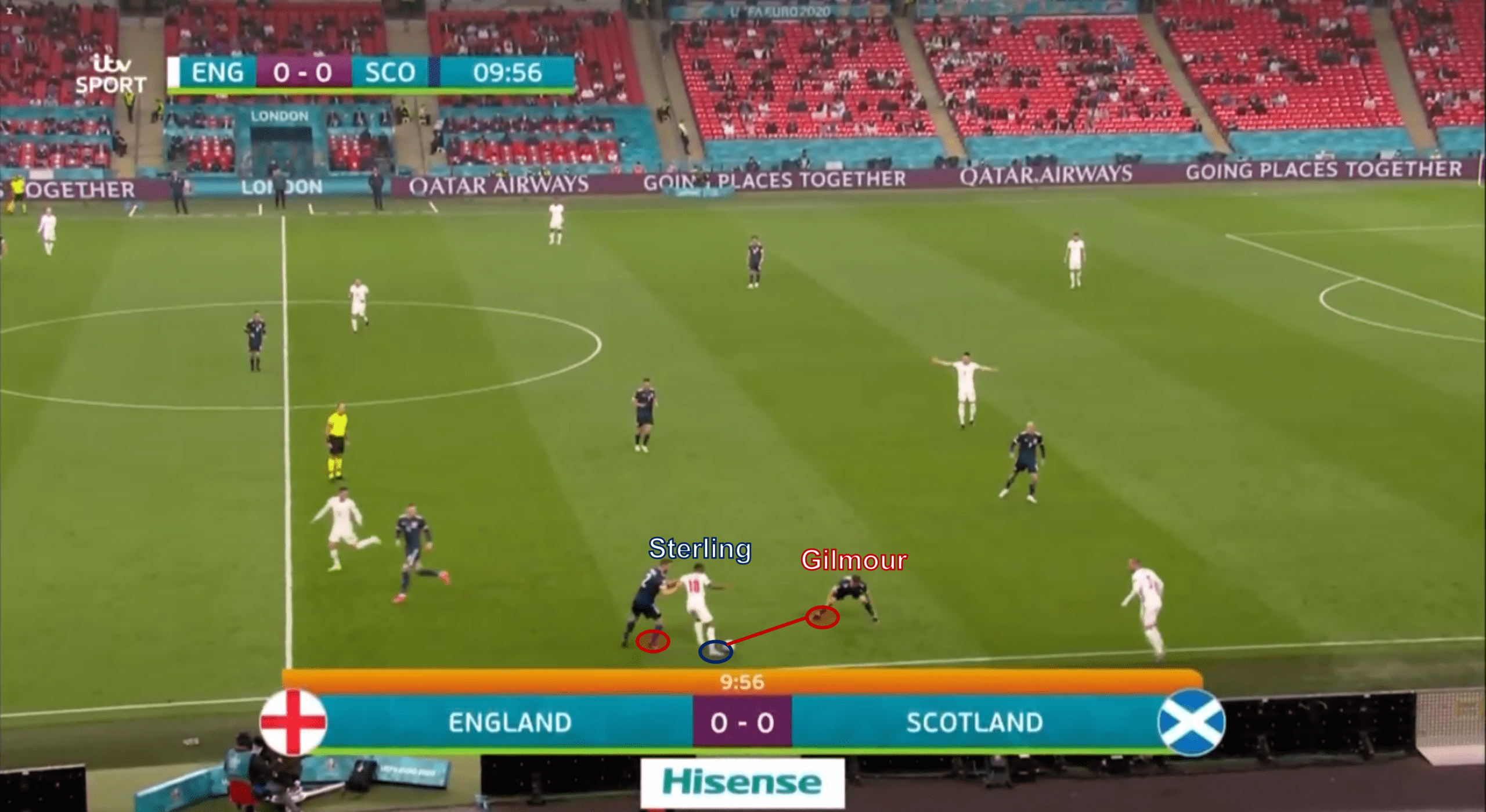
Sterling here is holding off a Scottish defender, whilst Gilmour is indecisive whether to step to his man or not.
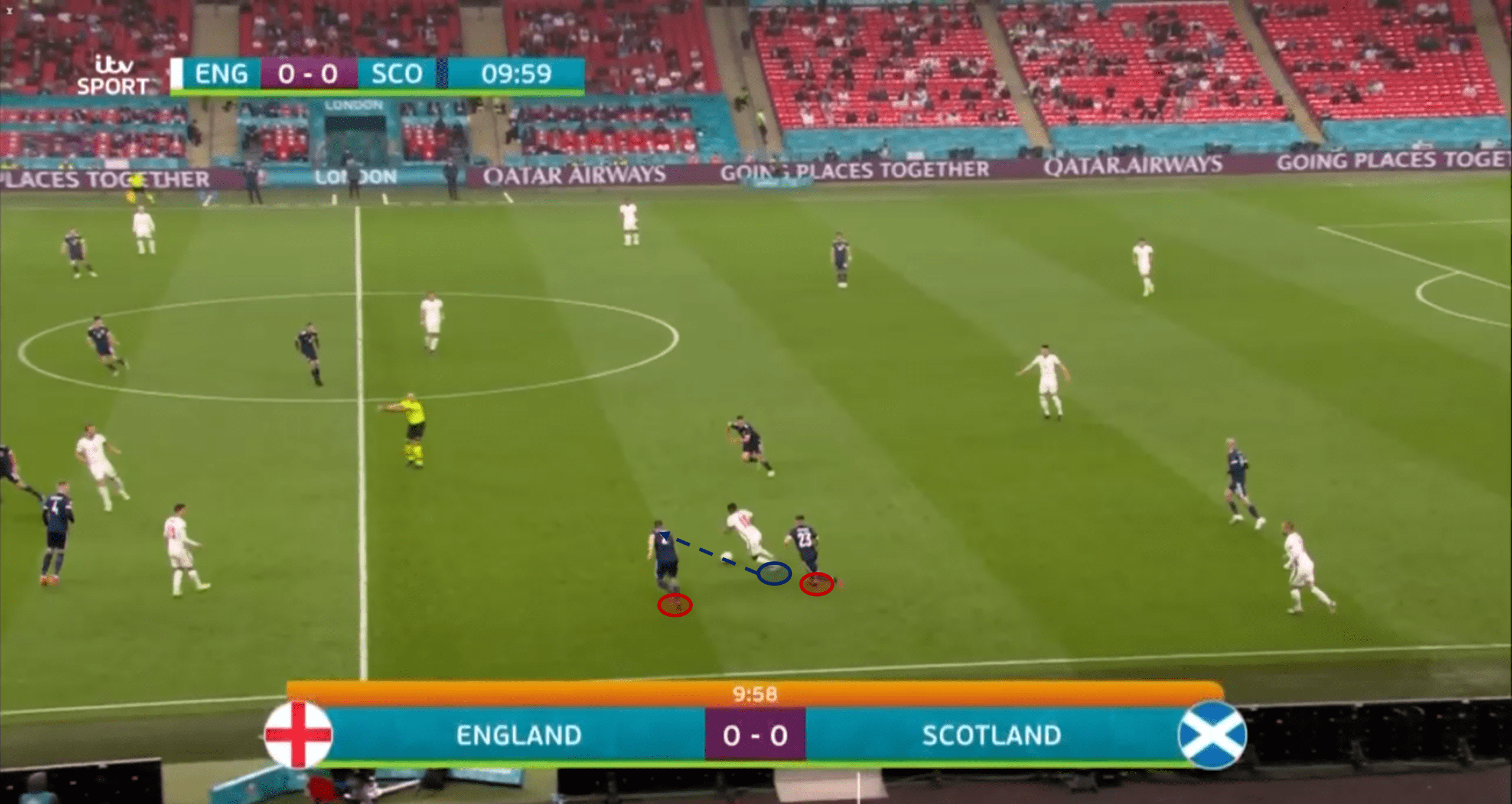
Sterling then escapes the pressure and strides into space, advancing up the pitch.
What Gilmour does not have, is the mobility to cover the defensive third laterally and protect the backline to a sufficient level on his own. Norwich will look to be more compact than their last endeavour in the topflight, so Gilmour will be accompanied by another midfielder, but this will almost certainly a player with defensive nous – essentially unlocking Gilmour’s world-class talent on the ball.
Could Skipp-Gilmour be the partnership?
How Gilmour will be used at Norwich has been discussed at length between the player and the club. The primary purpose of this deal is to gain Gilmour some sacred Premier League minutes regularly at this stage of his career, but Norwich also hope that the Scotsman can be one of their standout players in their return to the top flight too.
Farke, according to reports, is looking to introduce more tactical flexibility in the midfield – something which wasn’t necessary to win the Championship. This means operating with two 6s against teams they need to play more compact against, or a 6 and an 8 against sides they hope to be more dominant against in the centre. Gilmour will not be expected to replace Skipp’s role last season, though. Skipp was a mobile defensive midfielder who screened the back four superbly.
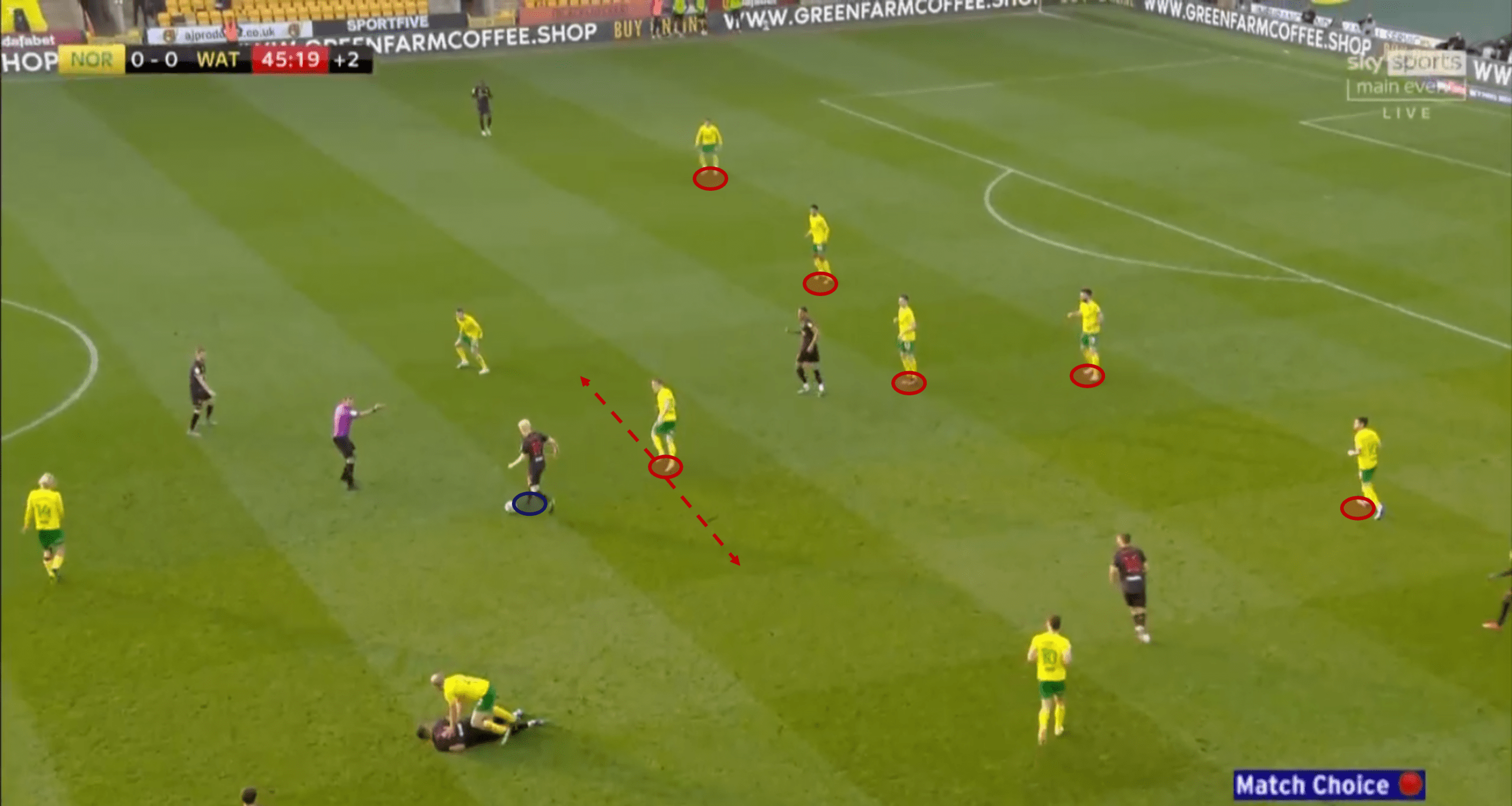
Here we can see an example of Skipp’s general defensive midfield positioning, screening laterally where the ball goes.
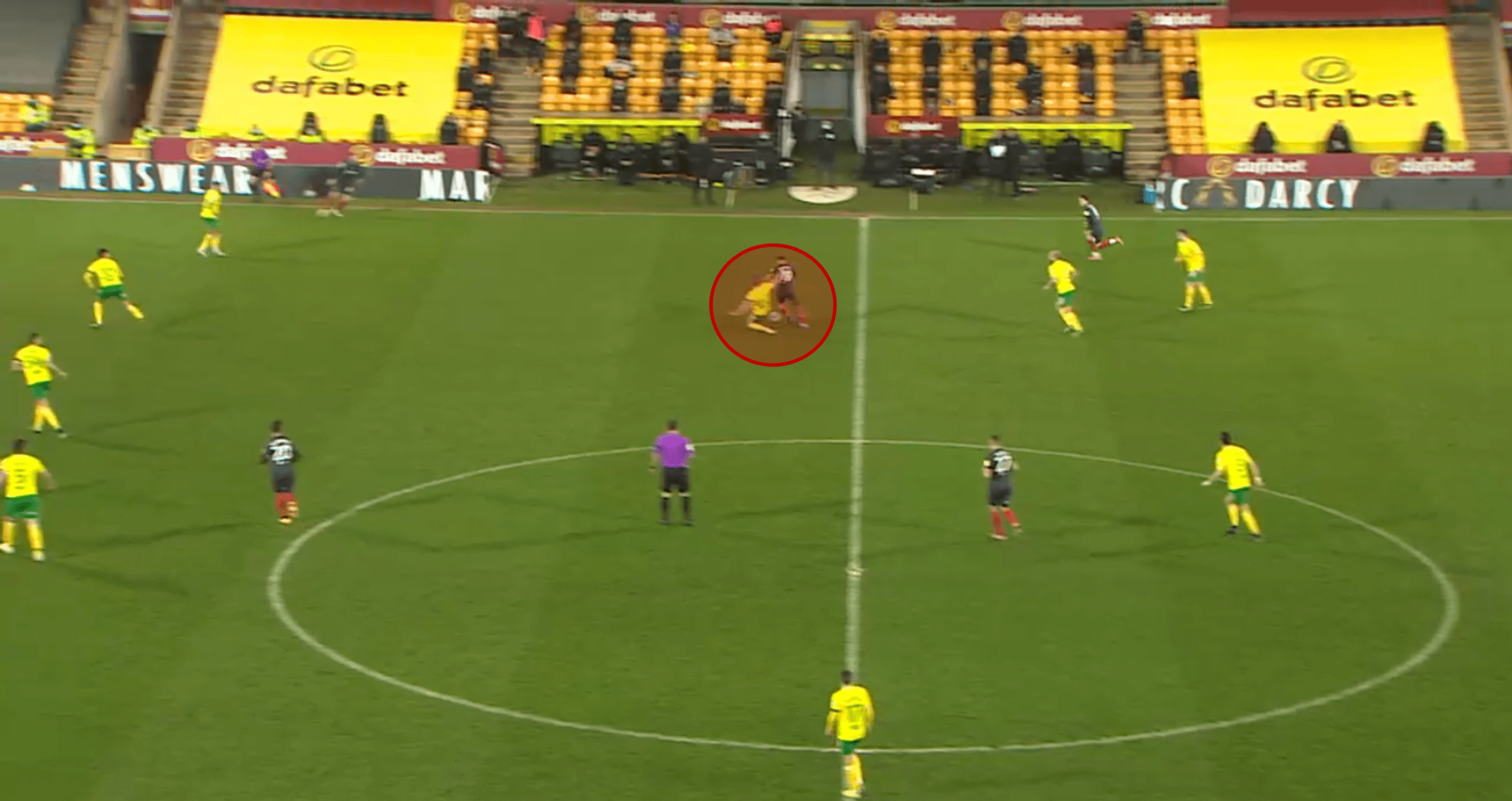
Here is an example of Skipp’s ability to tackle high up the pitch and recover possession in an advantageous position for the counterattack.
It is a possibility that Skipp returns for another season on loan, and Norwich supposedly see great potential in a partnership between the two young midfielders. That, of course, depends on Spurs, who would do well to give Skipp the Premier League minutes he deserves at a club and role he is familiar with. Otherwise, Bournemouth’s Phillip Billing has been rumoured alternative who could join the club on a permanent deal instead, who presents a wildly different physical profile, but a similar ability to cover lateral spaces just as Skipp did last season for the Canaries.
So, while Gilmour will start in a double pivot, he should have a partner who provides defensive security and allows the 20-year-old to perform his magic on the ball. Norwich will want to be compact but also advance the ball forward at a quicker pace than they did two seasons ago in the Premier League, with the goals drying up as the season went on. Farke has faith that Gilmour is a player who can provide that forward passing impetus at a top Premier League level, and the young midfielder has shown in the past that he can do just that for Chelsea in limited minutes.
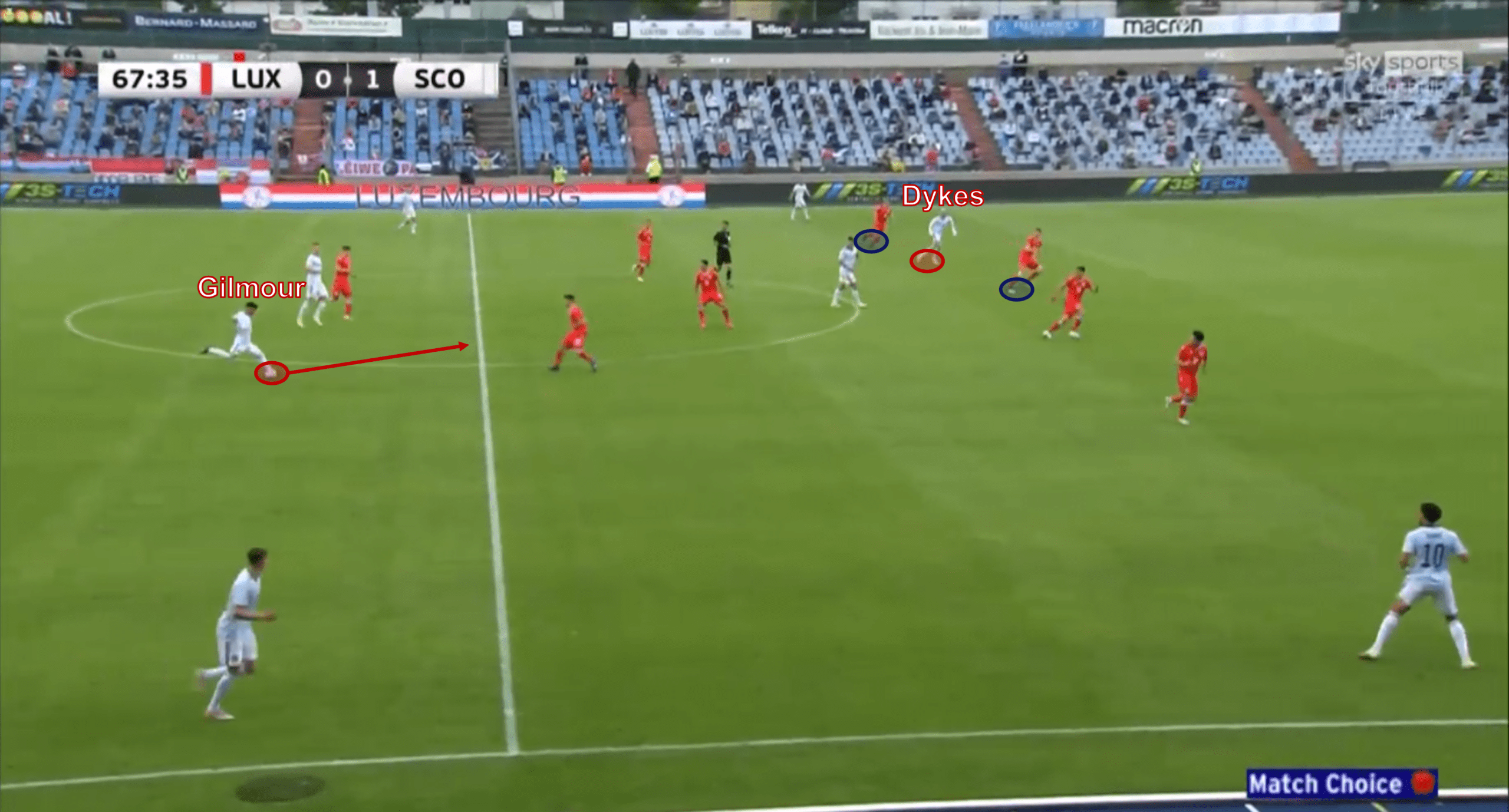
From a deeper position, Gilmour finds Lyndon Dykes with a long-range passing effort with the direct ball.
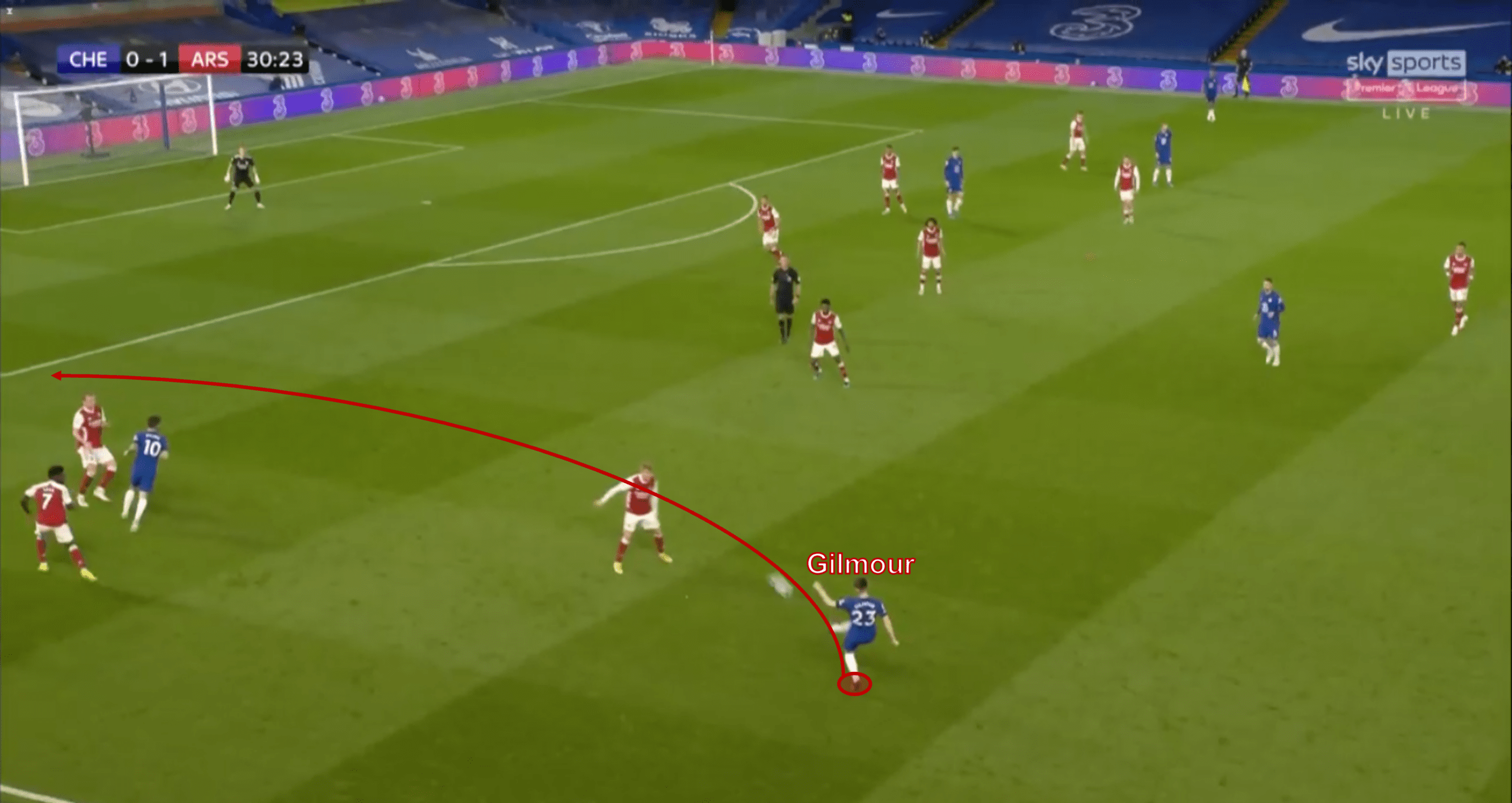
Another example of Gilmour’s long-range passing, here clipping the ball over to Ben Chilwell in an advanced wide-left position.
Gilmour can hurt teams with his passing from deeper positions. He has shown promising fundamentals when it comes to his vision, and an ability to pick out a line-breaking pass. His time on the pitch so far has not yet accompanied these passes with regularity, but he has demonstrated the ability to do so, now it will be Farke and the Norwich coaching team’s job to encourage this from him more frequently. This penetrative passing could mesh quite nicely with new summer signing Milot Rashica, a player most known for his goalscoring, pace, and clever movement into dangerous areas in the Bundesliga.
Forecast for the future
Billy Gilmour has caught the eye of the public, so the stakes are high for his success in the game, but so is his motivation to succeed as well. He stays humble and hungry, that much is clear, as he maintains a close relationship with his family despite being a fair distance away from him physically for most of the year. His game against England will only add to this building hype and momentum in his trajectory.
At club level, once the 2021/22 season ends, Chelsea’s current starting midfielders will be encroaching into their thirties and depending on how successful this loan spell is, Gilmour has a real claim to at least be a rotation option in the 2022/23 campaign. Although his potential is somewhat limited by his physical profile, Gilmour has worked hard to grind those deficiencies out of his game so that they are less noticeable, and he will continue to work on them. What Gilmour can provide is a world-class ability on the ball, and this does mean he can make it as an elite midfielder vying for Chelsea, fighting for titles. Every player has their drawbacks, but not all have the significant upside that Gilmour has.





Comments